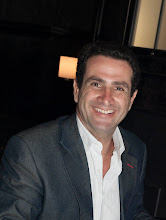 I am often asked to explain the meaning of my mask sculptures. It’s this very question that encourages me to explore masks as an artist. What other sculpture subject comes with the viewer so well prepared with deep cultural, historical and psychological notions? Masks are universally understood. As an object that hangs on the wall or a common component of human behavior, the idea of masks and masking is built into us.
I am often asked to explain the meaning of my mask sculptures. It’s this very question that encourages me to explore masks as an artist. What other sculpture subject comes with the viewer so well prepared with deep cultural, historical and psychological notions? Masks are universally understood. As an object that hangs on the wall or a common component of human behavior, the idea of masks and masking is built into us.The obvious use of masks, as in masquerade balls or Italian renaissance plays is not separate from the activity of personal grooming, putting on make-up or shaving, in that they are all activities that involve manipulating ones image. This common understanding of the language of masks makes them a complex sculptural form. The viewer layers on his or her own personalities and biases over their understanding of what may be a simple mask sculpture. Do I dare wear it? Do you wear it? When I put it on, what or who do I become and how shall I act? Would I like myself looking like that? Self-image is a timely and nurtured construct so masks can be confronting. The reason that I don’t make masks with an established cultural or historical tradition is that the viewer is unable to distance himself from its purpose and that purpose it to confront, involve and hopefully stimulate.
Leather has proved to be the perfect material for my aims. Realism, I believe, empowers the mask. The hint of a real face with actual skin texture, regardless of colour, can bring to life the mask especially if combined with believable facial features. Leather also has the unique ability to be formed into organic shapes while still retaining a skin feel. I collect a variety of commercially available hides for my work. The properties of the leather acquired will dictate what I can do with it. The variability of the properties of leather supports my need to continually modify the designs, allowing them to evolve. It’s this continuous evolution of design that keeps me fascinated with the masks. Today’s masks don’t look like yesterday’s masks and they won’t look like tomorrow’s.
When I colour the masks I focus on naturally occurring combinations of colours. Colour graduations are used to tie the face with its sculptural elements. By using opposites the effect of these elements can be heightened. With the acrylic and metallic paints I use dyes which allow the skin texture of the leather to be maintained, which of course is important to the work.
I recently discovered a pile of drawings that I thought had been thrown away a long time ago. They were produced around mid 1974 when I was an undergraduate at San Jose State University. I was studying to be a biologist with an art minor. At the time a class in invertebrate marine biology and cellular biology seemed completely at odds with classes in life drawing and painting. However these drawings have revealed something that only now I’ve come to realise. Clearly the two directions of study were intimately related. The drawings resemble scientific illustrations but are of pure abstract forms. My interest in biology was based on a fascination with microscopic symmetries. The mystery of organic forms, colours and processes captivated me in the same way as the wonder of fine art objects. I eventually went on to complete my studies in biology but it was the fine art that eventually dominated.
I can now see that these early drawings, my study in the sciences and especially these masks are about working on the same artistic challenge that is to emulate and or understand, to mimic the beauty of the organic form. My mask designs are based on combining the most lifelike facial features possible with elements that form a convincingly natural occurring symmetry.
I have recently been spending time listening, gathering viewer responses and observations and have been able to better understand how different design elements affect people. If I can make someone really like one mask and at the same time be repelled by another then I feel I’ve tapped in on a subconscious human language that recognises certain colours and forms as having specific meaning.
Michael Taylor.
































